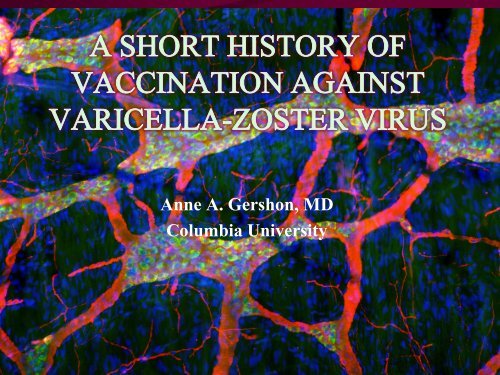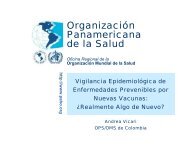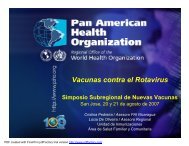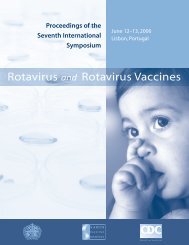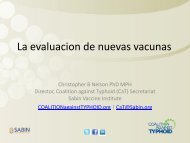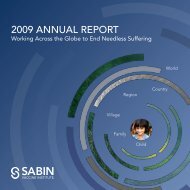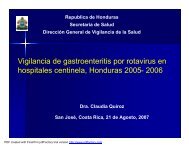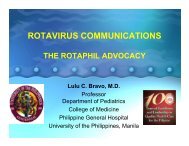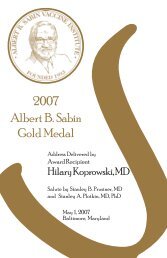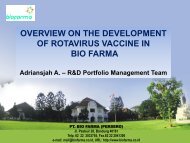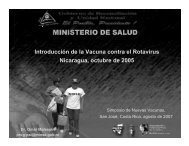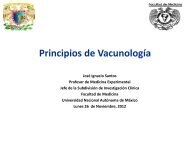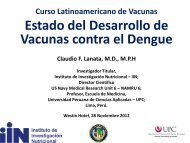View the winner's presentation (PDF) - Sabin Vaccine Institute
View the winner's presentation (PDF) - Sabin Vaccine Institute
View the winner's presentation (PDF) - Sabin Vaccine Institute
Create successful ePaper yourself
Turn your PDF publications into a flip-book with our unique Google optimized e-Paper software.
Anne A. Gershon, MD<br />
Columbia University
VZV infection presents a paradox<br />
VZV is highly infectious in vivo.<br />
But in vitro VZV spreads only slowly by<br />
cell-to-cell contact.<br />
Media contains no<br />
infectious virions.
VZV proliferates in <strong>the</strong> epidermis<br />
during varicella and zoster<br />
Vesicles<br />
contain intact<br />
virions<br />
VZV<br />
• Infectious virions are<br />
produced in and shed from<br />
<strong>the</strong> suprabasal epidermis,<br />
which lacks MPRs.<br />
DNA<br />
MPR
VZV in history<br />
• Varicella-zoster virus (VZV) is a very old virus<br />
(60-70 million years ago)<br />
• Historically varicella confused with smallpox<br />
and syphilis<br />
– Presumably led to name “chickenpox”<br />
• “Shingles” comes from Latin word for belt<br />
• No one seemed to worry about VZV in early 20 th<br />
century, although <strong>the</strong>re was occasional mortality<br />
• Weller isolated VZV in cell culture in 1953<br />
• Weller and Coons developed <strong>the</strong> fluorescent<br />
antibody technique in 1954, using VZV
Cheatham, Weller, et al. reported fatal varicella in one<br />
child being treated for neuroblastoma and ano<strong>the</strong>r on<br />
steroids for rheumatic fever in Boston, in 1956<br />
This child was my patient at Bellevue Hospital in about 1970
Zoster is common in immunosuppressed<br />
patients and may be severe<br />
Zoster may disseminate in immunocompromised hosts<br />
but is rarely fatal.
Saul Krugman had a 60 th birthday<br />
party at NYU in 1971<br />
• Philip Brunell, Anne<br />
Gershon, and Mike<br />
Gershon attended.<br />
• Brunell’s work on VZV<br />
sparked my interest in<br />
<strong>the</strong> virus.<br />
– VZV had <strong>the</strong> fascinating<br />
characteristic of latency
Big heroes dropped by and talked<br />
with little fellows at NYU in <strong>the</strong> ‘70s
FAMA is <strong>the</strong> “gold standard” for assessment of<br />
varicella immunity (immune correlate)<br />
• This fluorescent antibody<br />
test, developed with tools<br />
learned at Oxford, was<br />
introduced in 1974<br />
• After a household exposure<br />
to VZV, fewer than 2% of<br />
persons with a titer of ≥ 1:4,<br />
develop varicella (n=131).<br />
• Attack rate after household<br />
exposure in persons with a<br />
titer of
In <strong>the</strong> early 1970s <strong>the</strong>re were 3 potential<br />
approaches to fight VZV infections<br />
• Passive immunization<br />
(VZIG) in US, Canada<br />
• Antiviral <strong>the</strong>rapy<br />
– Not available<br />
• Active immunization:<br />
• Early attempts<br />
unsuccessful<br />
• attenuated vaccine,<br />
developed by Takahashi.<br />
• Highly controversial.
Takahashi published numerous small studies<br />
of varicella vaccine from Japan (1974-7)<br />
• Vaccinated 70 VZV-exposed hospitalized children<br />
without history of varicella (Lancet 1974)<br />
– 17% receiving steroids<br />
– 2 developed mild rash after 10-14 days<br />
– no cases of chickenpox<br />
• Was rash indicative of wild or vaccine type VZV?<br />
• Varicella occurred in 0/26 vaccinated but in 19/19 nonvaccinated<br />
(control) children with family exposures to<br />
VZV<br />
– Children with malignancy in remission were vaccinated<br />
(chemo<strong>the</strong>rapy interrupted)<br />
– little efficacy information
American virologists greeted Takahashi<br />
observations with controversy<br />
• Anti<br />
– Too little was known<br />
about VZV latency<br />
– Immunity to VZV was<br />
not understood-would<br />
infection be postponed to<br />
later life<br />
– VZV is a DNA virus and<br />
what would be <strong>the</strong><br />
consequences of putting<br />
modified viral DNA into<br />
human hosts?<br />
• Pro<br />
– Something had to be done<br />
to be done to prevent<br />
varicella.<br />
– Seasonal epidemics were<br />
unstoppable<br />
– Children were being<br />
cured of leukemia only to<br />
die of varicella<br />
– Available data highly<br />
encouraging
“In my judgment, <strong>the</strong> elimination of <strong>the</strong> varicellazoster<br />
problem is a desirable objective. I believe<br />
that <strong>the</strong> Takahashi varicella vaccine deserves more<br />
extensive study and clinical trials on an<br />
increasingly larger scale. If <strong>the</strong> reports of <strong>the</strong><br />
successful tests already carried out by Takahashi<br />
and his associates can be independently confirmed,<br />
<strong>the</strong> prospects for success are very good.”<br />
Albert <strong>Sabin</strong>, JAMA, October 1977
The FDA, BOB,<br />
NCI, and NIAID<br />
convened a<br />
workshop to<br />
discuss whe<strong>the</strong>r<br />
studies on<br />
varicella vaccine<br />
should be carried<br />
out in <strong>the</strong> United<br />
States<br />
Participants included:<br />
Drs. Jordan, Galasso,<br />
LaMontaigne, Plotkin,<br />
Krugman, Hilleman,<br />
Takahashi, Brunell,<br />
and Gershon
The first adult recipient of varicella<br />
vaccine was immunized at NYU<br />
• Pediatric intern, an<br />
only child, had never<br />
had varicella<br />
• Developed very mild<br />
rash after injection.<br />
• <strong>Vaccine</strong> had an<br />
unintended effect.<br />
– That intern devoted his<br />
life to <strong>the</strong> study of<br />
pediatric infectious<br />
disease (including<br />
varicella and zoster).
VZV FAMA Titer<br />
Immune responses to VZV in an adult vaccinee<br />
indicated protection and boosting<br />
VZV CMI<br />
<strong>Vaccine</strong> Rash Exposure 3 yr Exposure 7 yr<br />
Exposure 20 yr
Numerous studies of varicella<br />
vaccine followed<br />
• Open label collaborative clinical trial of children with ALL<br />
in remission (Gershon et al, JAMA 1984)<br />
– On maintenance chemo<strong>the</strong>rapy for at least 1 year (in remission)<br />
– Chemo<strong>the</strong>rapy stopped for 3 weeks for vaccination<br />
– Two doses proved necessary<br />
– Some rashes due to Oka but nothing serious<br />
– 85% completely protected from varicella; rest had mild disease<br />
• Two double blind studies in healthy children<br />
– One from USA (Weibel, 1984), one from Finland (Varis, 1996)<br />
– Highly protective, especially after large vaccine doses<br />
• Because some children with ALL required antiviral<br />
<strong>the</strong>rapy to treat Oka, decision was made to immunize<br />
healthy children<br />
– Led to proposal for universal vaccination of healthy susceptibles
Weller presents Takahashi with award<br />
at VZV meeting in Sorrento in 1994
Varicella <strong>Vaccine</strong> was licensed<br />
for universal use in US in 1995<br />
• Live attenuated vaccine (Oka)<br />
– Major adverse effect is mild rash in 5%<br />
– <strong>Vaccine</strong> is extremely safe<br />
• Over 80% of vaccinees are completely protected<br />
– Remainder develop mild infections<br />
• Little evidence of waning immunity with time<br />
– Incidence of breakthrough infection does not increase<br />
– Zoster is unusual<br />
• Two doses eventually proved necessary because of vaccine failures<br />
after 1 dose resulting in outbreaks at day schools.<br />
– Excellent record in health care workers (2 doses)<br />
• Accurate tests for immunity after vaccination not widely available.<br />
– FAMA not licensed.<br />
• Paved way for vaccine against HZ
Varicella vaccine is very effective: varicella<br />
incidence decreased with high vaccine coverage<br />
Antelope Valley* CA, U.S., 1995-2004<br />
600<br />
500<br />
400<br />
300<br />
200<br />
100<br />
Number of cases<br />
0<br />
Cases<br />
Vaccination coverage<br />
Vaccination<br />
coverage (%)<br />
1 7 1 7 1 7 1 7 1 7 1 7 1 7 1 7 1 7 1 7<br />
1995 1996 1997 1998 1999 2000 2001 2002 2003 2004<br />
100<br />
90<br />
80<br />
70<br />
60<br />
50<br />
40<br />
30<br />
20<br />
10<br />
0<br />
*Varicella Active Surveillance Project site<br />
Seward J et al, JAMA 2002;287 (5):606-611
Rate per 100,000 population<br />
Varicella Hospitalization Rates Fell 1994–2006<br />
6<br />
5<br />
(ACIP Recommendation 1 dose)<br />
4<br />
3<br />
(ACIP Recommendation:<br />
2 doses in 2006)<br />
2<br />
CDC DATA ,<br />
COURTESY<br />
1<br />
JANE<br />
SEWARD<br />
0<br />
Year<br />
0 to 4 yrs 5 to 9 yrs 10 to 19 yrs 20 to 49 yrs 50+ yrs
Varicella-related mortality rates in <strong>the</strong><br />
United States, 1990 –2007<br />
Marin et al, Pediatrics, 2011
<strong>Vaccine</strong> effectiveness,<br />
% (95% CI)<br />
Varicella vaccine effectiveness over time<br />
(case-control study) showed little or no<br />
waning of immunity<br />
100<br />
80<br />
60<br />
40<br />
20<br />
0<br />
1 2 3 4 5 6 7 to 8 2 to 8<br />
Years since varicella vaccination<br />
Adapted from Vásquez et al. JAMA 2004;291:851-855. Yale-Columbia study
Two <strong>Vaccine</strong> Doses Were Highly<br />
Effective in a Case Control Study<br />
Number of<br />
doses received<br />
Cases,<br />
N = 71 (%)<br />
Controls,<br />
N = 140 (%)<br />
p value<br />
(7) (0.8)<br />
doses<br />
2 doses<br />
1 dose<br />
66 (93) 117 (83.6)<br />
22 (15.7)<br />
The effectiveness of 2 doses of varicella<br />
vaccine vs 1 dose was 98.3%<br />
Shapiro et al. JID 2011; Yale-Columbia Study
Vaccination Prevents Varicella in HIVinfected<br />
children<br />
Rate Per 1000 person years<br />
p
The incidence of zoster in<br />
vaccinees is low<br />
• Adult incidence is extremely low<br />
– (0.9/1000 person-years; [P-Y])<br />
• Lower rates in leukemic vaccinees than in<br />
leukemics after natural infection<br />
– (4 studies in 1980s)<br />
• Lower rates in healthy vaccinees<br />
– 0.3/1000 P-Y 4-fold decrease in risk<br />
– 1/3 of cases due to wild type virus<br />
• No zoster in vaccinated HIV-infected children
Will <strong>the</strong> incidence of zoster increase in<br />
non-vaccinated individuals?<br />
• Modeling predicted zoster incidence will double within 40<br />
years, with significantly increased mortality<br />
– Studies show zoster incidence has increased since 1950s.<br />
– But ascertaiment, numbers of aged, individuals with<br />
immunocompromising illnesses, diabetes, stress have also<br />
increased.<br />
• Recent study showed incidence of zoster in isolated<br />
populations and general public is similar.<br />
– (Gilliat et al, CID 2011)<br />
• Asymptomatic reactivation may stimulate immunity to<br />
VZV
Asymptomatic patients may experience<br />
increases in VZV antibody titer<br />
• Luby et al described increases in CF titer in 6/12 renal<br />
transplant patients in 1977<br />
• Could have resulted from exposure to VZV<br />
• Against this possibility were frequency of increases, lack of seasonal distribution<br />
• Luby proposed that <strong>the</strong> phenomenon was due to an<br />
“unstable equilibrium between <strong>the</strong> virus and <strong>the</strong> host”<br />
• Supported <strong>the</strong> hypo<strong>the</strong>sis of Hope Simpson of subclinical<br />
release of virus with increases in VZV immunity<br />
• Magnified and measurable in immunocompromised hosts<br />
• Luby et al, JID 1977; Hope Simpson Proc Roy Soc Med 1965
Edgar Hope-Simpson studied <strong>the</strong><br />
epidemiology of zoster in people of<br />
various ages in his medical practice<br />
1998<br />
Hope Simpson proposed that <strong>the</strong>re was periodic reactivation of latent<br />
VZV that stimulated long term immunity to <strong>the</strong> virus; when this was<br />
overcome, zoster occurred
Reactivation of VZV without rash has<br />
demonstrated by <strong>the</strong> transitory<br />
presence VZV DNA in saliva<br />
• 1/3 of astronauts shed non-infectious VZV in saliva<br />
following space flight<br />
• Some patients with unilateral pain syndromes have VZV<br />
DNA in saliva<br />
• 17 % of hospitalized children have VZV DNA in saliva<br />
• Question: could latency and mild/asymptomatic<br />
reactivation help to provide long term persistence of<br />
immunity to VZV?
Ann Arvin<br />
Paula Annunziato<br />
Judith Breuer<br />
Jason Chen<br />
Kathryn Edwards<br />
Perry Gershon<br />
Iain Hardy<br />
Phillip LaRussa<br />
Octavian Lungu<br />
Collaborators<br />
Michael Gershon<br />
David Michalik<br />
Richard Perkin<br />
Wanda Setlik<br />
Jane Seward<br />
Saul Silverstein<br />
Sharon Steinberg<br />
Lisa Wang<br />
Jerry Zhu
In conclusion<br />
• I am thrilled to have received <strong>the</strong> <strong>Sabin</strong> Gold Medal<br />
• I have had <strong>the</strong> tremendous good fortune to have worked<br />
with wonderful colleagues, including family members<br />
• Varicella and zoster vaccines have profited greatly from <strong>the</strong>ir<br />
input<br />
• I was especially privileged to have personally interacted with<br />
<strong>Sabin</strong>, Krugman, Weller, and Takahashi<br />
• Most importantly, our combined effort has helped to<br />
make lives better for children and <strong>the</strong>ir families<br />
• We can prevent <strong>the</strong> devastation and expense that VZV used to<br />
cause. VZV vaccines are a big success.!


